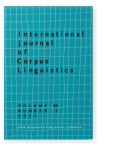Vol. 26:3 (2021) ► pp.305–335
Problematising characteristicness
A biomedical association case study
Keyness is a commonly used method in corpus linguistics and is assumed to identify key items that are characteristic of 1 corpus when compared to another. This paper puts this assumption to the test by comparing case study corpora in the fields of genetic, immunological and psychiatric biomedical association studies, using what we refer to as a ‘K-FLUX’ analysis to produce a set of key items. Experts from within these fields are asked to evaluate the extent to which identified key items are characteristic of their discipline. The paper concludes that less than 50% of the items identified by the method are rated as highly characteristic by experts and that this ranges between types of association study. Further, there is difficulty in reaching a consensus over what is deemed to be ‘characteristic’, thus posing a challenge to the ultimate aim of the keyness method. The paper demonstrates the value of supporting corpus linguistic studies with expert assessments to evaluate whether (and which) items can be said to be indicative of a particular field.
Article outline
- 1.Introduction
- 2.Using keyness to determine characteristicness
- 3.Data
- 4.Words, lemmas and word families
- 5.Generating key items for evaluation
- 5.1Procedure
- 5.2Results
- 6.Evaluation studies
- 6.1Study 1: Pilot study
- 6.1.1Procedure
- 6.1.2Results and discussion
- 6.2Study 2: Wider evaluative study
- 6.2.1Procedure
- 6.2.2Results
- 6.2.3Discussion
- 6.1Study 1: Pilot study
- 7.General discussion and conclusion
- Notes
-
References
